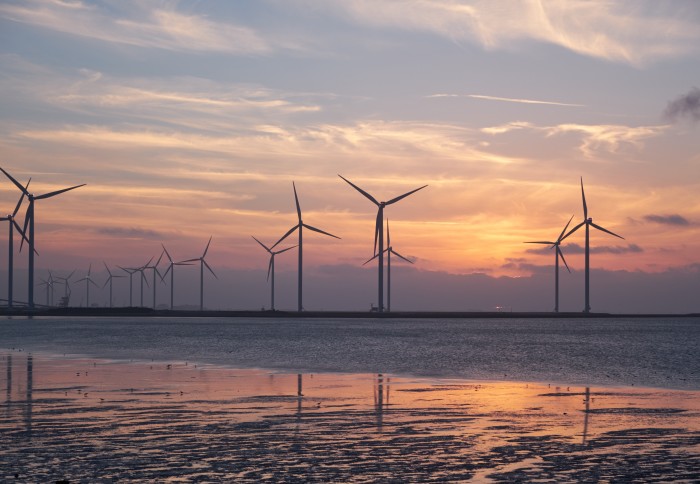Revolutionising wind energy: EPSRC fellowship awarded to optimise wind farms
by Tom Creese

Dr Oliver Buxton has been awarded an EPSRC fellowship to develop tools designed to optimise the layouts of wind farms.
The research will tackle problems found in existing wind farm layouts, with the ultimate aim to create a tool that optimises layouts to maximise the efficiency of wind-power generation.
“This is a fantastic opportunity for us to present solutions to challenging problems encountered in wind energy. " Dr Oliver Buxton Senior Lecturer, Department of Aeronautics
The project, titled ‘Accurate modelling of wind turbine wake spreading through consideration of realistic entrainment: revolutionising wind farm optimisation', is worth £1.57 million over five years.
Further in-kind support is provided by partners Vestas (one of the largest wind turbine manufacturers in the world), Frazer-Nash Consultancy (whose portfolio includes wind farm design) and the University of Oldenburg, Germany (one of the pre-eminent wind energy research groups in Europe).
The funding allows for the recruitment of two PhD students and two post-doctoral researchers, travel to Germany and Vestas' facility on the Isle of Wight, plus time in the Department’s 10x5 Wind Tunnel for experimental testing.
Layout problems
The need for this research is shown by problems encountered in existing layouts of wind farm designs.

Dr Buxton explains “A typical wind farm layout is in neat rows, with uniform spacing between turbines. This is rather arbitrary: the probability that such a layout would be optimal for delivering wind power is impossibly small”.
There are a few reasons why wind farms are not laid out efficiently.
One is that the physics of the turbulent wakes produced by wind turbines are not fully understood. As a result, existing modelling strategies for these turbulent wakes are not sufficiently accurate to optimise farm layouts. If a turbine is positioned behind another upstream wind turbine, it produces less power than a wind turbine in isolation.
"We intend to make this wind-farm optimisation tool open-source to attract as many users as possible worldwide" Dr Oliver Buxton Senior Lecturer, Department of Aeronautics
Furthermore, wind turbine components (like its blades and gearbox) can suffer fatigue damage and breakage, due to unsteady inflows caused by turbulent wakes of other turbines upstream. The turbines, therefore, need downtime for maintenance, which has a detrimental effect on the overall power generated.
Dr Buxton explains that “To layout a wind farm optimally, you want to maximise the total amount of power produced whilst reducing maintenance downtime and costs. This requires advances in our understanding of the physics of turbulent wakes. Better understanding of these physics must then translate to better models."
Finally, the research aims to provide a better understanding of the interaction between wake turbulence and wind turbine components. "This will enable us to better predict fatigue damage, and therefore the layouts of future farms can be optimised by predicting the maintenance downtime as well as the overall power production"
Global Blockage
Another problem faced in wind energy production is the ‘Global Blockage problem’.
“Imagine you’re in a forest,” Dr Buxton explains “even if it’s quite a windy day, you won’t really experience the full speed of the wind, because the density of trees will obstruct it. The wind will divert over or around the forest. A wind farm is similar since the wind farm itself represents a blockage.”
The blockage means that turbines experience the wind at a reduced velocity, adversely affecting the amount of power they produce. A failure to model this blockage has been a problem for wind farm operators, whose overall power yields have been lower than anticipated.
Optimisation tool
The research aims to tie together solutions to these issues. A better understanding of the physics behind the blockage caused by wind farms and the physics of wind turbine wakes will enable researchers to produce better turbulent wake models both for individual turbines and at the farm level.
Also, with improved understanding of the interaction between turbulence and the turbines’ components, researchers and designers are expected to be able to better predict fatigue lifetimes and maintenance schedules for turbines. With this knowledge, optimal farm layouts can be devised.
Dr Buxton adds "We intend to make this wind-farm optimisation tool open-source to attract as many users as possible worldwide, who will use it to design the wind farms of the future. This will be vital in ensuring that the UK (and other) governments meet their clean energy targets."
“This is a fantastic opportunity for us to present solutions to challenging problems encountered in wind energy. There’s potential for this to be hugely beneficial for wind power and helping us to transition to sustainable energy production”.
Article text (excluding photos or graphics) © Imperial College London.
Photos and graphics subject to third party copyright used with permission or © Imperial College London.
Reporter
Tom Creese
Department of Aeronautics